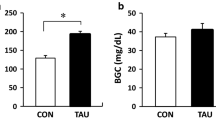Abstract
The Zn metabolism in experimental diabetic rats after maximal exercise was investigated. Forty male wistar rats were used, weighing 240±10 g at the beginning of this experiment. The animals were assigned to one of four experimental groups (n=10): control at rest (CR), control plus exercise (CE), diabetic at rest (DR), and diabetic plus exercise (DE). Experimental diabetes was produced by a single intraperitoneal injection of streptozotocin (STZ) (60 mg/kg). Thirty days after injection of streptozotocin, the animals of groups CE and DE were forced to acute exercise (swimming) until exhaustion. Glucose, rectal temperature (RT), pH, swimming time (ST), hematocrit (Hct), serum, and tissue (heart, liver, kidney, and muscle) Zn concentrations were measured. The streptozotocin treated animals used in the current experiment were diabetic. Increases in hepatic, renal muscle, and serum levels Zn at rest and after exercise until exhaustion were found in normal and diabetic rats. ST decreased (−180%) in the diabetic rat group. In conclusion, the results of the present study indicate that STZ-induced diabetes was associated with altered tissue Zn concentration, both at rest and after exercise.
Similar content being viewed by others
References
E. S. Horton,Diab. Care 11, 201 (1988).
M. Vranic and M. Berger,Diabetes 28, 147 (1979).
B. Jacober, R. M. Schmulling, and M. Sggstein,Int. J. Sports Med. 4, 104 (1983).
D. H. Wasserman and N. N Abumrad,Sports Med. 7, 376 (1989).
N. J. Christensen, H. Galbo, J. F. Hansen, B. Hesse, E. A. Richter, and J. Trapjensen,Diabetes 28, 28 (1979).
M. L. Failla and R. A. Kiser,J. Nutr. 111, 1900 (1981).
R. J. Cousins,Physiol. Rev. 65, 238 (1985).
J. H. Lee, M. Konarka, and R. McCarty,Physiol. Behav. 45, 483 (1989).
M. L. Failla and C. Y. Gardell,Proc. Soc. Exp. Biol. Med. 180, 317 (1985).
W. T. Johnson and G. W. Evans,J. Nutr. 114, 180 (1984).
A. M. Huber and S. N. Gershoff,J. Nutr. 103, 1739 (1973).
P. McNair, S. Killerich, C. Christiansen, M. S. Christensen, S. Madsbad, and I. Transbol,Clin. Chim. Acta 112, 343 (1981).
A. Córdova, F. J. Navas, L. M. Elosegui, and J. F. Escanero,Magnesium, in press.
I. Raz and E. Hahvivi,Diab. Res. 7, 19 (1988).
M. L. Failla and R. A. Kiser,Am. J. Physiol. 244, E115 (1983).
R. E. Serfass, K. E. Park, and M. L. Kaplan,Proc. Soc. Exp. Biol. Med. 189, 229 (1988).
S. H. Oh, J. T. Deagen, P. D. Whanger and P. H. Weswig,Am. J. Physiol. 234, E282 (1978).
A. Córdova and V. Villar,Rev. Esp. Fisiol. 46, 399 (1990).
K. James, M. Merriman, R. S. Gray, L. J. P. Duncan, and R. Herd,J. Clin. Pathol. 33, 163 (1980).
P. Pozzilli, U. Dimario, M. Javicoli, M. Chinca, and M. Orsini,Horm. Metab. Res. 12, 409 (1980).
W. W. Campbell and R. A. Anderson,Sports Med. 4, 9 (1987).
T. Watanabe, A. Morimoto, Y. Sakata, N. Tan, K. Morimoto, and N. Murakami,J. Appl. Physiol. 73, 2452 (1992).
A. Córdova, M. Gimenez and J. F. Escanero,J. Trace Elem. Electrolytes Health Dis. 4, 189 (1990).
A. Córdova, M. Giminez, and J. F. Escanero,Physiol. Behav. 48, 596 (1990).
A. Córdova, F. J. Navas, and J. F. Escanero,Biol. Trace Elem. Res. 39, 13 (1993).
A. Córdova, J. L. Anghileri and C. Saunier,Physiol. Behav. 55, 413 (1994).
W. T. Johnson and W. K. Canfield,J. Nutr. 115, 1217 (1985).
M. Gimenez, A. Córdova, J. L. Anghileri, and J. F. Escanero,Nutrition et Sport, Masson, Paris (1990).
H. Ohno, K. Yamashita, R. Doi, K. Yamamura, T. Kondo, and N. Taniguchi,J. Appl. Physiol. 58, 1453 (1985).
A. S. Prasad,Trace Elements and Iron in Human Metabolism, Plenum, 1979.
R. D. Murphy, A. C. Vailas, C. M. Tipton, R. D. Matthes, and J. G. Edwards,J. Appl. Physiol. 50, 482 (1981).
R. B. Armstrong and C. D. Ianuzzo,Horm. Metab. Res. 8, 392 (1976).
Author information
Authors and Affiliations
Rights and permissions
About this article
Cite this article
Cordova, A. Zinc content in selected tissues in streptozotocin-diabetic rats after maximal exercise. Biol Trace Elem Res 42, 209–216 (1994). https://doi.org/10.1007/BF02911518
Received:
Accepted:
Issue Date:
DOI: https://doi.org/10.1007/BF02911518




